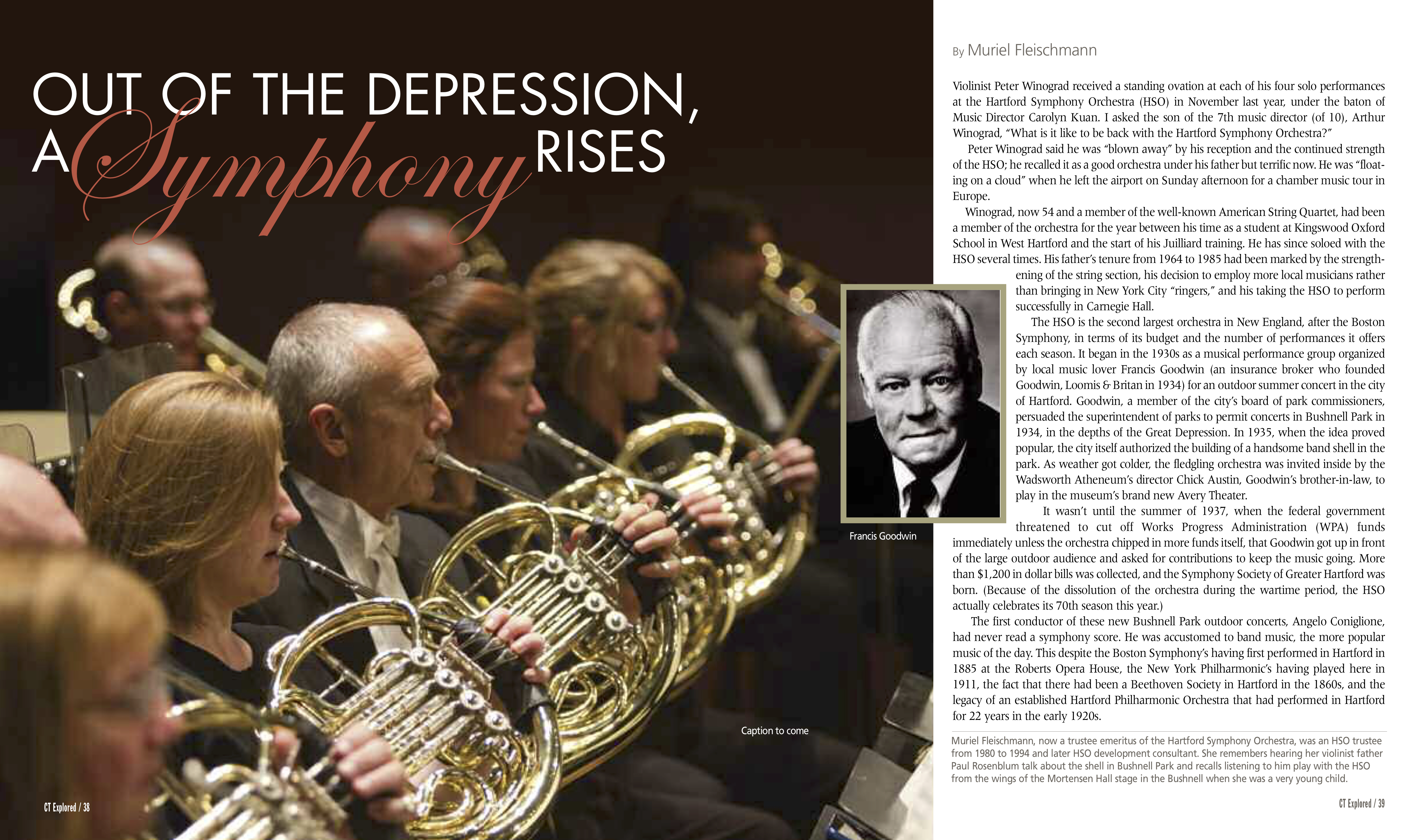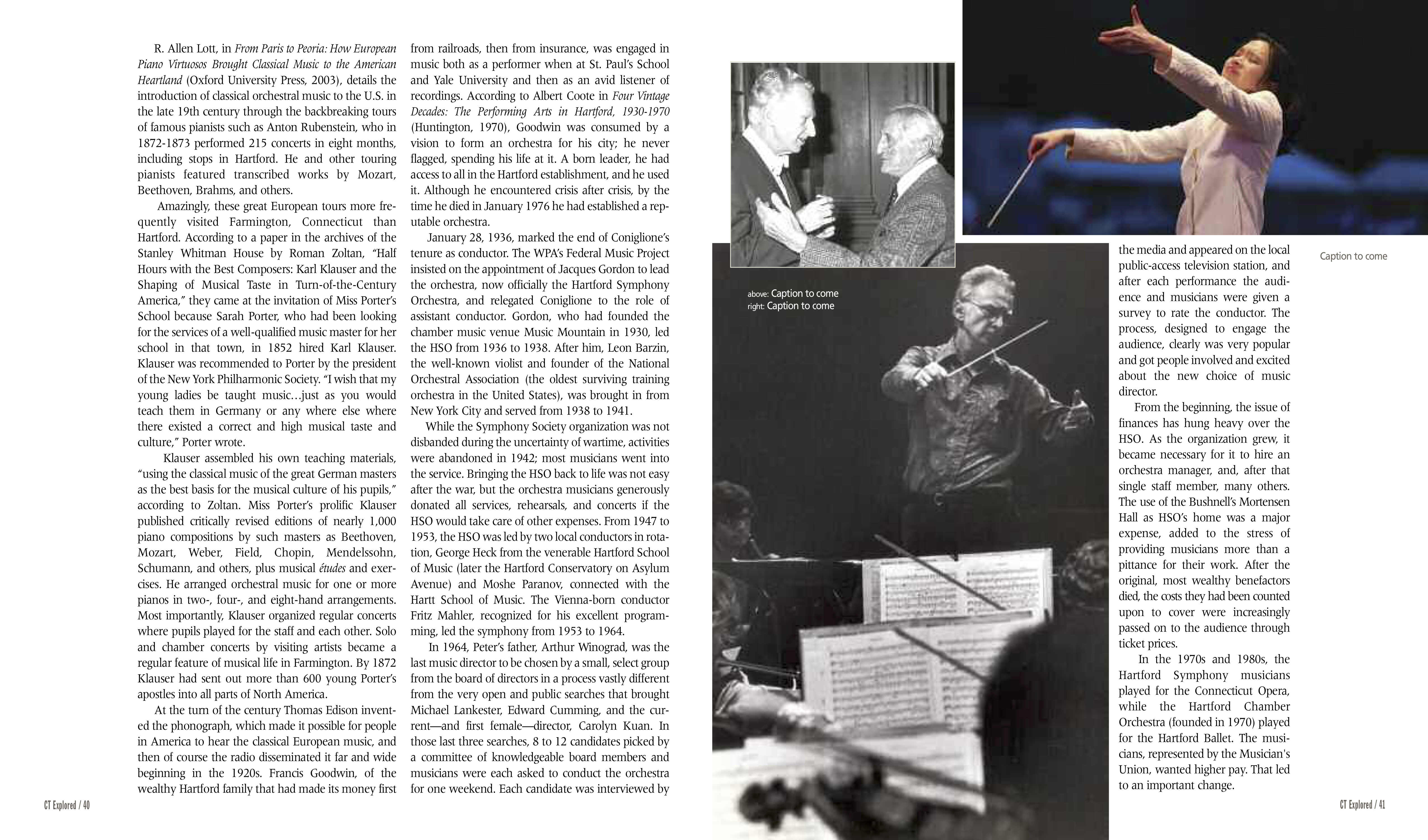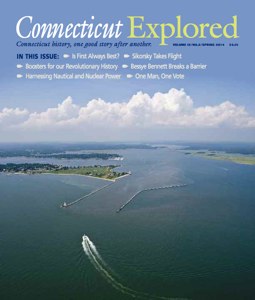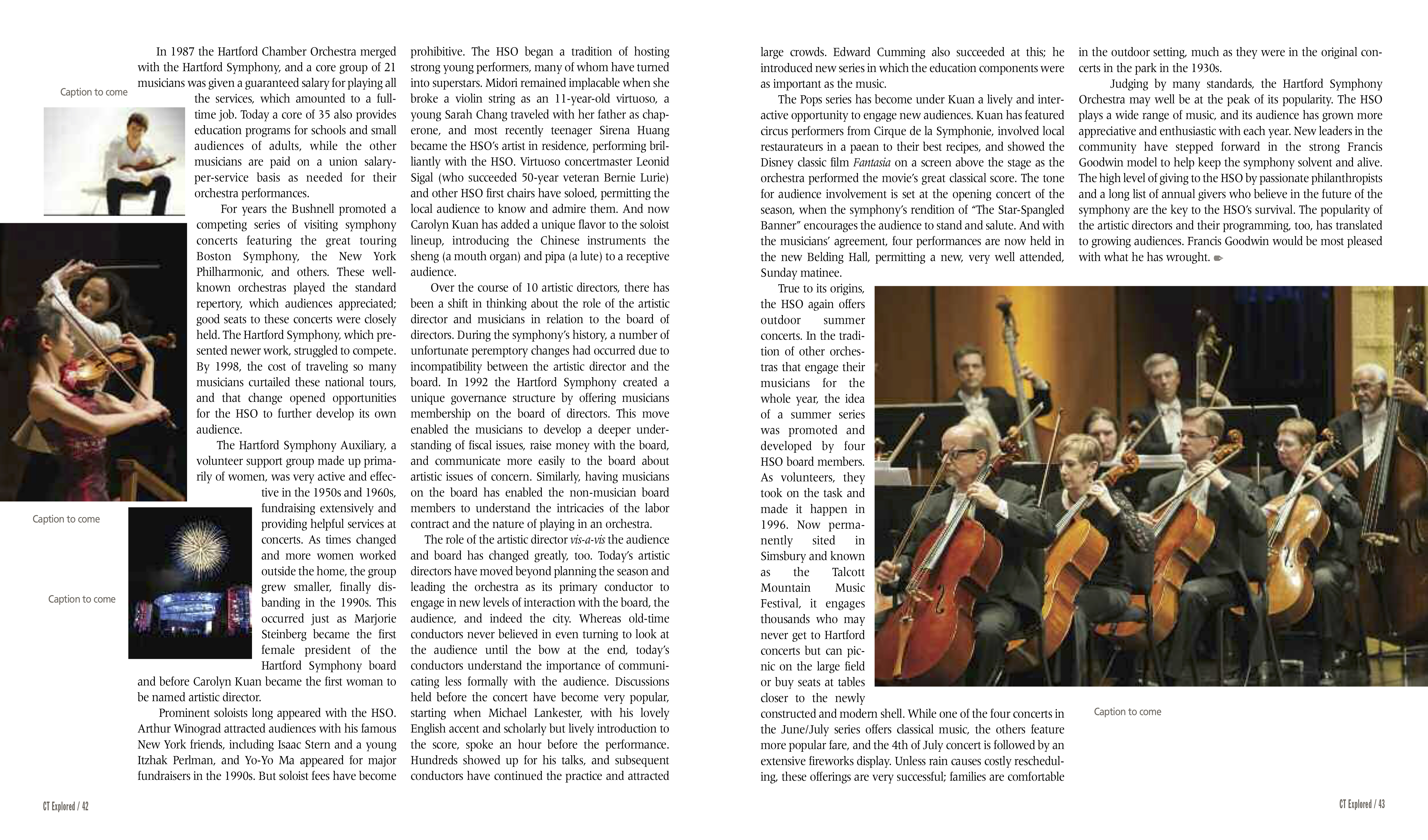By Muriel Fleischmann
 (c) Connecticut Explored Inc. Spring 2014
(c) Connecticut Explored Inc. Spring 2014
Subscribe/Buy the Issue!
Violinist Peter Winograd received a standing ovation at each of his four solo performances at the Hartford Symphony Orchestra (HSO) in November 2013, under the baton of Music Director Carolyn Kuan. I asked the son of the 7th music director (of 10), Arthur Winograd, “What is it like to be back with the Hartford Symphony Orchestra?”
Peter Winograd said he was “blown away” by his reception and the continued strength of the HSO; he recalled it as a good orchestra under his father but terrific now. He was “floating on a cloud” when he left the airport on Sunday afternoon for a chamber music tour in Europe.
Winograd, 54 and a member of the well-known American String Quartet, had been a member of the orchestra for the year between his years as a student at Kingswood Oxford School in West Hartford and the start of his Juilliard training. He has since soloed with the HSO several times.His father’s tenure from 1964 to 1985 had been marked by the strengthening of the string section, his decision to employ more local musicians rather than bringing in New York City “ringers,” and his taking the HSO to perform successfully in Carnegie Hall.
The HSO is the second largest orchestra in New England, after the Boston Symphony, in terms of its budget and the number of performances it offers each season. It began in the 1930s as a musical performance group organized by local music lover Francis Goodwin for an outdoor summer concert in the city of Hartford. Goodwin, a member of the city’s board of park commissioners, persuaded the superintendent of parks to permit concerts in Bushnell Park in 1934, in the depths of the Great Depression. In 1935, when the idea proved popular, the city itself authorized the building of a handsome band shell in the park. As weather got colder, the fledgling orchestra was invited inside by the Wadsworth Atheneum’s director Chick Austin, Goodwin’s brother-in-law, to play in the museum’s brand new Avery Theater.
It wasn’t until the summer of 1937, when the federal government threatened to cut off Works Progress Administration funds immediately unless the orchestra chipped in more funds itself, that Goodwin got up in front of the large outdoor audience and asked for contributions to keep the music going. More than $1,200 in dollar bills was collected, and the Symphony Society of Greater Hartford was born. (Because of the dissolution of the orchestra during the wartime period, the HSO actually celebrates its 70th season this year.)
The first conductor of these new Bushnell Park outdoor concerts, Angelo Coniglione, had never read a symphony score. He was accustomed to band music, the more popular music of the day.This in spite of the fact that the Boston Symphony had first performed in Hartford in 1885 at the Roberts Opera House, The New York Philharmonic had played here in 1911, the fact that there had been a Beethoven Society in Hartford in the 1860s, and the legacy of an established Hartford Philharmonic Orchestra that had performed in Hartford for 22 years in the early 1920s.
 R. Allen Lott, in From Paris to Peoria: How European Piano Virtuosos Brought Classical Music to the American Heartland(Oxford University Press, 2003),details the introduction of classical orchestral music to the U.S. in the late 19th century through the backbreaking tours of famous pianists such as Anton Rubenstein, who in 1872-1873 performed 215 concerts in eight months, including stops in Hartford. He and other touring pianists featured transcribed works by Mozart, Beethoven, Brahms, and others.
R. Allen Lott, in From Paris to Peoria: How European Piano Virtuosos Brought Classical Music to the American Heartland(Oxford University Press, 2003),details the introduction of classical orchestral music to the U.S. in the late 19th century through the backbreaking tours of famous pianists such as Anton Rubenstein, who in 1872-1873 performed 215 concerts in eight months, including stops in Hartford. He and other touring pianists featured transcribed works by Mozart, Beethoven, Brahms, and others.
Amazingly, these great European tours more frequently visited Farmington, Connecticut than Hartford. According to a paper in the archives of the Stanley Whitman House by Roman Zoltan, “Half Hours with the Best Composers: Karl Klauser and the Shaping of Musical Taste in Turn-of-the-Century America,” they came at the invitation of Miss Porter’s School because Sarah Porter, who had been looking for the services of a well-qualified music master for her school in that town, in 1852 hired Karl Klauser. Klauser was recommended to Porter by the president of theNew York Philharmonic Society. “I wish that my young ladies be taught music…just as you would teach them in Germany or any where else where there existed a correct and high musical taste and culture,” Porter wrote.
Klauser assembled his own teaching materials, “using the classical music of the great German masters as the best basis for the musical culture of his pupils.” Miss Porter’s prolific Klauser published critically revised editions of nearly 1,000 piano compositions by such masters as Beethoven, Mozart, Weber, Field, Chopin, Mendelssohn, Schumann, and others, plus musical étudesand exercises. He arranged orchestral music for one or more pianos in two-, four-, and eight-hand arrangements. Most importantly, Klauser organized regular concerts where pupils played for the staff and each other. Solo and chamber concerts by visiting artists became a regular feature of musical life in Farmington. By 1872 Klauser had sent out more than 600 young Porter’s apostles into all parts of North America.
 At the turn of the century Thomas Edison invented the phonograph, which made it possible for people in America to hear the classical European music, and then of course the radio disseminated it far and wide beginning in the 1920s. Francis Goodwin, of the wealthy Hartford family that had made its money first from railroads, then from insurance, was engaged in music both as a performer when at St. Paul’s School and Yale University and then as an avid listener of recordings. According to Albert Coote in Four Vintage Decades: The Performing Arts in Hartford, 1930-1970(Huntington, 1970), Goodwin was consumed by a vision to form an orchestra for his city; he never flagged, spending his life at it. A born leader, he had access to all in the Hartford establishment, and he used it. Although he encountered crisis after crisis, by the time he died in January 1976 he had established a reputable orchestra.
At the turn of the century Thomas Edison invented the phonograph, which made it possible for people in America to hear the classical European music, and then of course the radio disseminated it far and wide beginning in the 1920s. Francis Goodwin, of the wealthy Hartford family that had made its money first from railroads, then from insurance, was engaged in music both as a performer when at St. Paul’s School and Yale University and then as an avid listener of recordings. According to Albert Coote in Four Vintage Decades: The Performing Arts in Hartford, 1930-1970(Huntington, 1970), Goodwin was consumed by a vision to form an orchestra for his city; he never flagged, spending his life at it. A born leader, he had access to all in the Hartford establishment, and he used it. Although he encountered crisis after crisis, by the time he died in January 1976 he had established a reputable orchestra.
January 28, 1936, marked the end of Coniglione’s tenure as conductor. The WPA’s Federal Music Project insisted on the appointment of Jacques Gordon to lead the orchestra, now officially the Hartford Symphony Orchestra, and relegated Coniglione to the role of assistant conductor. Gordon, who had founded the chamber music venue Music Mountain in 1930, led the HSO from 1936 to 1938. After him, Leon Barzin, the well-known violist and founder of the National Orchestral Association (the oldest surviving training orchestra in the United States) was brought in from New York City and served from 1938 to 1941.
While the Symphony Society organization was not disbanded during the uncertainty of wartime, activities were abandoned in 1942; most musicians went into the service. Bringing the HSO back to life was not easy after the war, but the orchestra musicians generously donated all services, rehearsals, and concerts if the HSO would take care of other expenses. From 1947 to 1953, the HSO was led by two local conductors in rotation, George Heck from the venerable Hartford School of Music (later the Hartford Conservatory on Asylum Avenue) and Moshe Paranov, connected with the then-fledgling Hartt School of Music. The Vienna-born conductor Fritz Mahler, recognized for his excellent programming, led the symphony from 1953 to 1964.
In 1964, Peter’s father, Arthur Winograd, was the last music director to be chosen by a small, select group from the board of directors in a process vastly different from the very open and public searches that brought Michael Lankester, Edward Cumming, and the current—and first female—director, Carolyn Kuan. In those last three searches, 8 to 12 candidates picked by a committee of knowledgeable board members and musicians were each asked to conduct the orchestra for one weekend. Each candidate was interviewed by the media and appeared on the local public-access television station, and after each performance the audience and musicians were given a survey to rate the conductor. The process, designed to engage the audience, clearly was very popular and got people involved and excited about the new choice of music director.
From the beginning, the issue of finances has hung heavy over the HSO. As the organization grew, it became necessary for it to hire an orchestra manager, and, after that single staff member, many others. The use of the Bushnell’s Mortensen Hall as HSO’s home was a major expense, added tothe stress of providing musicians more than a pittance for their work. After the original, most wealthy benefactors died, the costs they had been counted upon to cover were increasingly passed on to the audience through ticket sales.
In the 1970s and 1980s, the Hartford Symphony musicians played for the Connecticut Opera, while the Hartford Chamber Orchestra (founded in 1970) played for the ballet. The musicians, represented by the Musician’s Union, wanted higher pay. That led to an important change.
In 1987 the Hartford Chamber Orchestra merged with the Hartford Symphony, and a core group of 21 musicians was given a guaranteed salary for playing all the services, which amounted to a full-time job. Today a core of 35 provides education programs for schools and small audiences of adults, while the other musicians are paid on a union salary-per-service basis as needed for their orchestra performances.
For years the Bushnell promoted a competing series of visiting symphony concerts featuring the great touring Boston Symphony, the New York Philharmonic, and others. These well-known orchestras played the standard repertory, which audiences appreciated; good seats to these concerts were closely held. The Hartford Symphony, which presented newer work, struggled to compete. By 1998, the cost of traveling so many musicians curtailed these national tours, and that change opened opportunities for the HSO to further develop its own audience.
The Hartford Symphony Auxiliary, a volunteer support group made up primarily of women, was very active and effective in the 1950s and 1960s, fundraising extensively and providing helpful services at concerts. As times changed and more women worked outside the home, the group grew smaller, finally disbanding in the 1990s. This occurred just as Marjorie Steinberg became the first female president of the Hartford Symphony board and before Carolyn Kuan became the first woman to be named artistic director.
Prominent soloists long appeared with the HSO. Arthur Winograd attracted audiences with his famous New York friends, including Isaac Stern and a young Itzhak Perlman, and Yo-Yo Ma appeared for major fundraisers in the 1990s. But soloist fees have become prohibitive. The HSO began a tradition of hosting strong young performers, many of whom have turned into superstars. Midori remained implacable when she broke a violin string as an 11-year-old virtuoso, a young Sarah Chang traveled with her father as chaperone, and most recently teenager Sirena Huangbecame the HSO’s artist in residence, performing brilliantly with the HSO. Virtuoso concertmaster Leonid Sigal (who succeeded 50-year veteran Bernie Lurie) and other HSO first chairs have soloed, permitting the local audience to know and admire them. And now Carolyn Kuan has added a unique flavor to the soloist lineup, introducing the Chinese instruments the sheng (a mouth organ) and pipa (a lute) to a receptive audience.
Over the course of 10 artistic directors, there has been a shift in thinking about the role of the artistic director and musicians in relation to the board of directors. During the symphony’s history, a number of unfortunate peremptory changes had occurred due to incompatibility between the artistic director and the board. In 1992 the Hartford Symphony created a unique governance structure by offering musicians membership on the board of directors. This move enabled the musicians to develop a deeper understanding of fiscal issues, raise money with the board, and communicate more easily to the board about artistic issues of concern. Similarly, having musicians on the board has enabled the non-musician board members to understand the intricacies of the labor contract and the nature of playing in an orchestra.
The role of the artistic director vis-a-visthe audience and board has changed greatly, too. Today’s artistic directors have moved beyond planning the season and leading the orchestra as its primary conductor to engage in new levels of interaction with the board, the audience, and indeed the city. Whereas old-time conductors never believed in even turning to look at the audience until the bow at the end, today’s conductors understand the importance of communicating less formally with the audience. Discussions held before the concert have become very popular, starting when Michael Lankester, with his lovely English accent and scholarly but lively introduction to the score, spoke an hour before the performance. Hundreds showed up for his talks, and subsequent conductors have continued the practice and attracted large crowds. Edward Cumming also succeeded at this; he introduced new series in which the education components were as important as the music.
The Pops series has become under Kuan a lively and interactive opportunity to engage new audiences. Kuan has featured circus performers from Cirque de la Symphonie, involved local restaurateurs in a paean to their best recipes, and this year showed the Disney classic film Fantasiaon a screen above the stage as the orchestra performed the movie’s great classical score. The tone for audience involvement is set at the opening concert of the season, when the symphony’s rendition of “The Star-Spangled Banner” encourages the audience to stand and salute. And with the musicians’ agreement, four performances are now held in the new Belding Hall, permitting a new, very well attended, Sunday matinee.
True to its origins, the HSO again offers outdoor summer concerts. In the tradition of other orchestras that engage their musicians for the whole year, the idea of a summer series was promoted and developed by four HSO board members. As volunteers, they took on the task and made it happen in 1996. Now permanently sited in Simsbury and known as the Talcott Mountain Music Festival, it engages thousands who may never get to Hartford concerts but can picnic on the large field or buy seats at tables closer to the newly constructed and modern shell. While one of the four concerts in the June/July series offers classical music, the others feature more popular fare, and the Fourth of July concert is followed by an extensive fireworks display. Unless rain causes costly rescheduling, these offerings are very successful; families are comfortable in the outdoor setting, much as they were in the original concerts in the park in the 1930s.
Judging by many standards, the Hartford Symphony Orchestra may well be at the peak of its popularity. The HSO plays a wide range of music, and its audience has grown more appreciative and enthusiastic with each year. New leaders in the community have stepped forward in the strong Francis Goodwin model to help keep the symphony solvent and alive. The high level of giving to the HSO by passionate philanthropists and a long list of annual givers who believe in the future of the symphony are the key to the HSO’s survival. The popularity of the artistic directors and their programming, too, has translated to growing audiences. Francis Goodwin would be most pleased with what he has wrought.
Muriel Fleischmann, now a trustee emeritus of the Hartford Symphony Orchestra, was an HSO trustee from 1980 to 1994 and later HSO development consultant. She remembers hearing her violinist father Paul Rosenblum play with the HSO when she was a very young child.

